Zion National Park, a majestic red-rock wonderland in southwestern Utah, is a beacon for adventurers, photographers, and nature lovers alike. With its towering cliffs, narrow canyons, and diverse ecosystems, Zion offers an unforgettable landscape that’s both challenging and serene. This article aims to guide visitors on how to make the most of their experience within the One Day in Zion National Park. Whether you’re hiking the strenuous trails to Angel’s Landing or wading through the Virgin River in The Narrows, planning is key to maximizing your day in this natural wonder.
How to Get to Zion National Park
Zion National Park is closest to Las Vegas’ Harry Reid International Airport, situated about 175 miles away. The journey to the park is an ideal addition to a brief Utah road trip or an extensive adventure through Arizona and Utah.
For those who prefer not to drive, shuttle services and guided tours are available from Las Vegas to the park. Be prepared for heavy traffic and limited parking in Zion, a situation that persists even beyond the peak summer months. According to the park’s official website, parking spaces are usually filled by early morning (8 or 9 a.m.). In Springdale, the town adjacent to Zion, you’ll find paid parking options and a complimentary shuttle service that transports visitors directly into Zion National Park.
One Day in Zion National Park
Let’s get into the exciting details! This itinerary for one day in Zion National Park is filled with must-see locations and plenty of photography inspiration. I’ve organized the guide into sections: Morning, Midday, Afternoon, and Evening.
Morning Activities
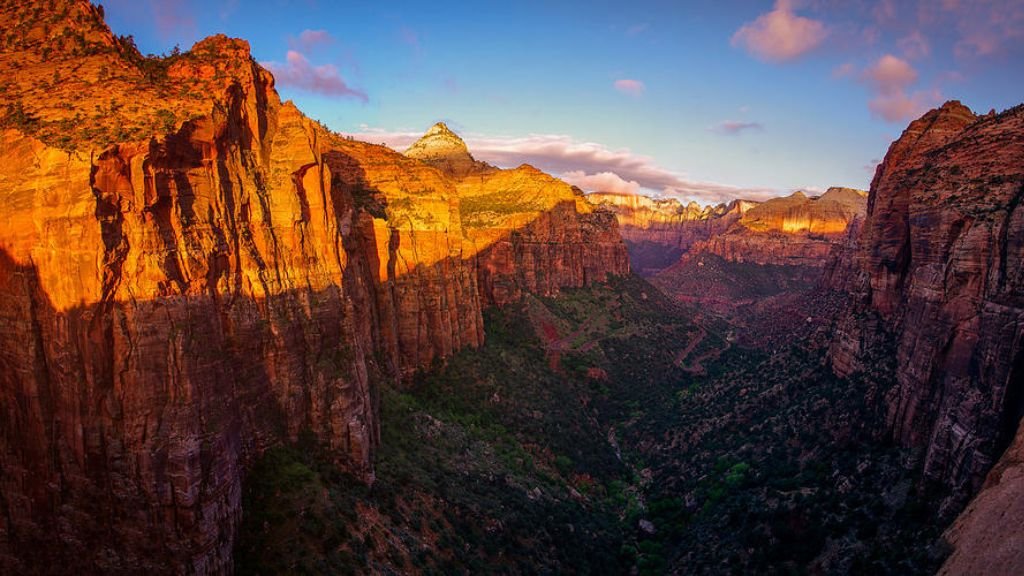
Sunrise Viewing Spots: Zion National Park offers some of the most breathtaking sunrise views in the American Southwest. Begin your day by experiencing the first light at Canyon Junction Bridge, where the Watchman Peak stands majestically against the rising sun. Another remarkable spot is Observation Point, accessible via a challenging hike, which rewards you with panoramic views of the canyon illuminated by the morning sun. These locations offer not only stunning photography opportunities but also a peaceful start to your day in Zion.
Early Morning Hikes: To make the most of the cooler morning temperatures and lighter crowds, consider embarking on an early morning hike. The Canyon Overlook Trail is a relatively easy 1-mile round trip that provides spectacular views of the Zion Canyon. For a slightly longer route, the Emerald Pools Trail offers a series of trails leading to beautiful waterfalls and tranquil pools, with the lower pool being easily accessible and offering a refreshing start to the day.
Related: Day Trips From Prague
Midday: Exploring Zion
Must-See Landmarks: As the day progresses, immerse yourself in the awe-inspiring landscapes of Zion. Don’t miss the Narrows, a majestic slot canyon hike through the Virgin River, where towering walls embrace the sky. Angels Landing is another iconic hike, offering exhilarating views from atop a narrow ridge. For a less strenuous experience, visit Weeping Rock, a short trail leading to a rock alcove with dripping springs, showcasing the delicate beauty of Zion’s landscape.
Lunch in the Park: For a midday break, Zion offers several picturesque picnic areas and dining options. The Zion Lodge provides a sit-down meal with views of the surrounding cliffs, or you can opt for a picnic at one of the many designated areas, such as the Grotto Picnic Area, which is shaded and near the Virgin River, offering a perfect spot to relax and refuel for the afternoon.
Afternoon Adventures
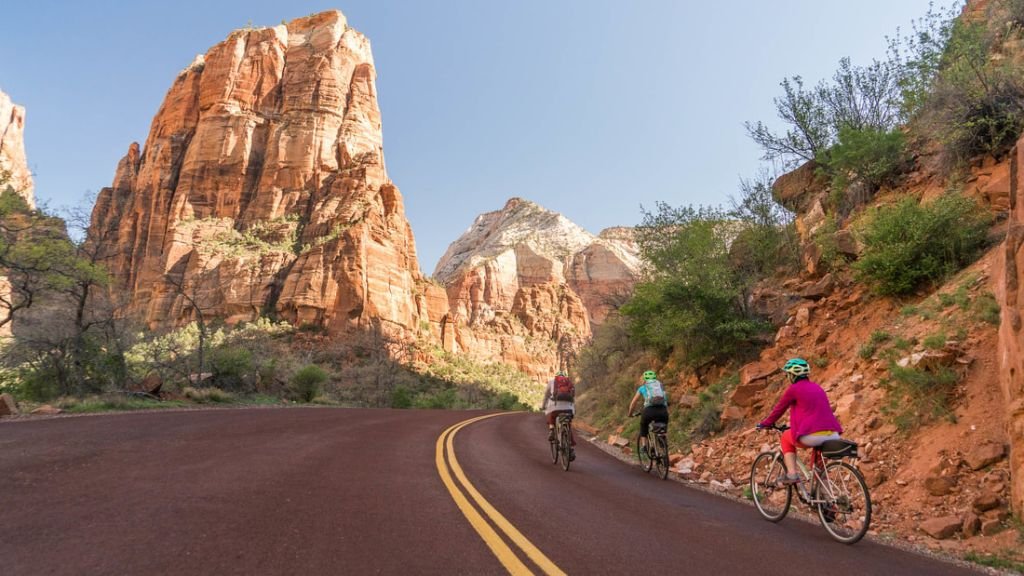
Guided Tours and Activities: Zion’s diverse landscape is ripe for exploration through various ranger-led programs or adventure tours. Engage in rock climbing or canyoneering with expert guides to safely experience Zion’s vertical world. For families and individuals interested in learning more about the park, ranger-led talks and walks provide insightful information about the park’s geology, wildlife, and history.
Scenic Drives: Spend your afternoon marveling at Zion’s beauty from the comfort of your vehicle. The Zion Canyon Scenic Drive is a must-do, with access to many of the park’s main attractions. Note that this road is accessible by the park shuttle system during peak tourist seasons to reduce congestion. This drive, or a ride on the shuttle, allows you to enjoy the towering cliffs and stunning canyons at a leisurely pace, with several stops to explore further or capture photographs of the breathtaking scenery.
Embracing these activities will ensure your day in Zion National Park is filled with awe-inspiring experiences and memories that will last a lifetime.
Evening: Relax and Reflect
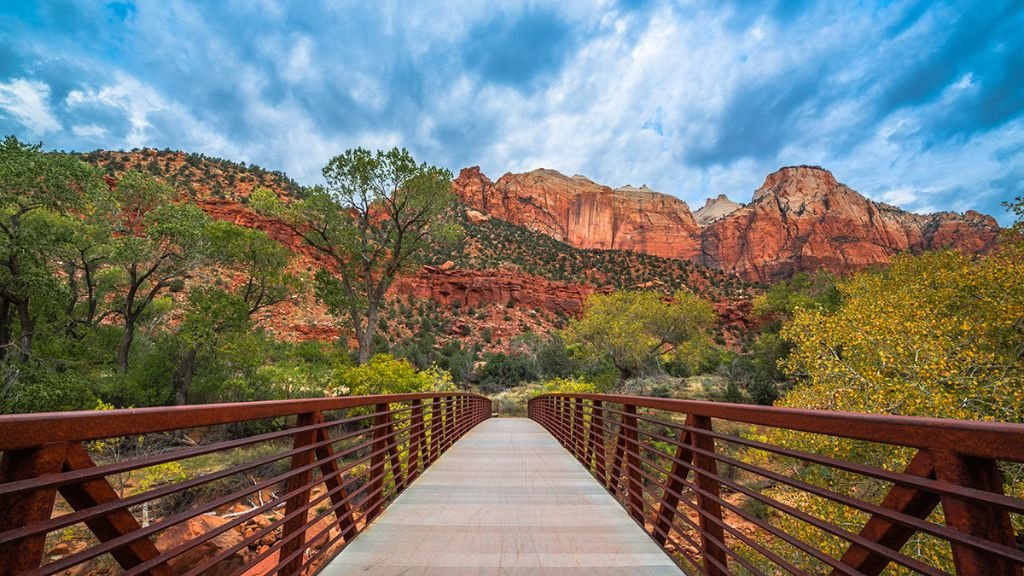
Sunset Spots: As the day winds down, Zion National Park transforms under the glow of the setting sun, offering serene and picturesque moments. The Canyon Junction Bridge is not only perfect for sunrise but also for sunset, where the Watchman Peak is bathed in warm hues. Kolob Terrace provides a less crowded experience, with vast landscapes turning golden under the setting sun. These spots offer a moment of reflection and relaxation after a day of adventure, allowing you to soak in the majestic beauty of Zion in tranquility.
Stargazing: After the sun sets, Zion’s clear night skies come alive with stars, making it an excellent spot for stargazing. The Zion Canyon and Kolob Canyons areas, away from light pollution, offer some of the best celestial views. Late spring through early fall offers the clearest skies, though the park’s high elevation means year-round stargazing opportunities. Remember to bring a blanket and a telescope or binoculars, if possible, to enhance your stargazing experience.
Read More: Best Things to Do in Badlands National Park
One Day in Zion National Park Itinerary
This list highlights the top activities for one day in Zion National Park itinerary. It features the best hikes, scenic drives, and viewpoints to ensure you check off the most essential experiences from your Zion bucket list!
Canyon Overlook Trail
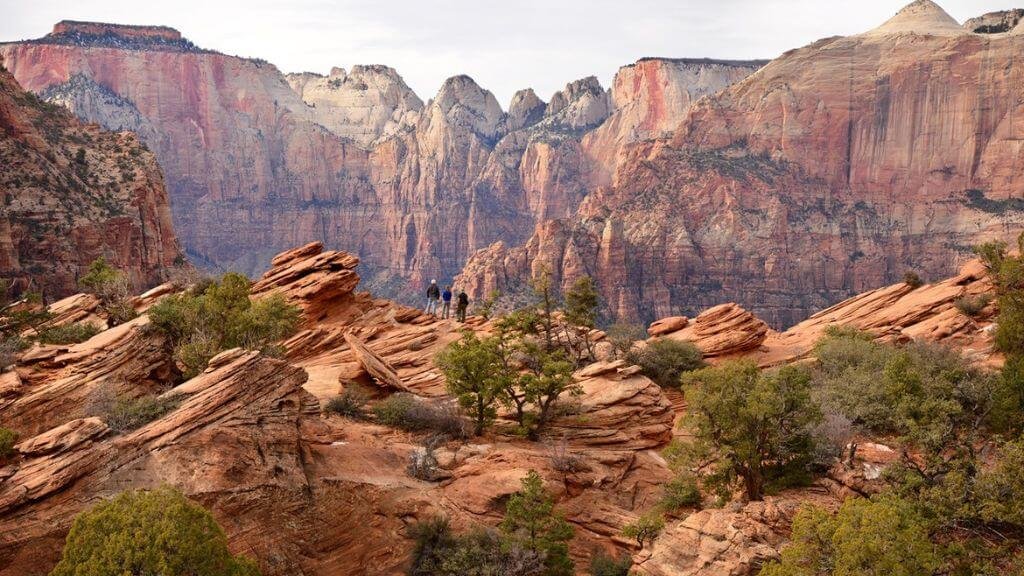
For a brief yet scenic excursion, consider the Canyon Overlook Trail. This trail, positioned above the canyon floor, offers a stunning view without requiring much ascent.
At a mile-long round trip and of moderate difficulty, this path affords a panoramic view of the lower Zion Canyon and Pine Creek Canyon.
Located just before the Zion-Mount Carmel Tunnel on the east side, finding parking can be a challenge, especially during peak times, as the area is not serviced by the park shuttle.
The Narrows Hike
The Narrows Hike, featuring parts where the Virgin River narrows to 20-30 feet across beneath towering canyon walls, is a must-do in Zion National Park. The hike begins easily with the Riverside Walk and transitions to wading and sometimes swimming in the river for the 9.4-mile round trip. Given its out-and-back nature, hikers can turn back at any point.
This hike requires preparation for river conditions and potential flash flooding. It’s generally advised for late spring through summer to avoid cold water, and proper equipment is essential for safety. Information and gear rentals are available in Springdale.
While The Narrows is a highlight of Zion, dedicating 3 to 4 hours allows time to explore other park features. Plan to hike in for half the allotted time before returning, to ensure a balanced visit.
Riverside Walk
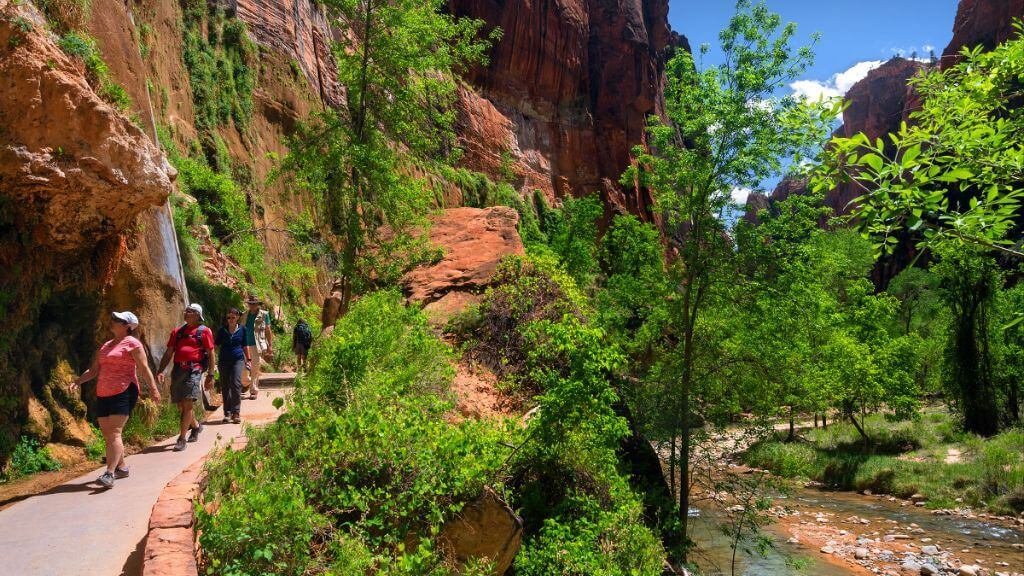
This accessible trail meanders along the Virgin River, flanked by towering canyon walls. Stretching 2.2 miles back and forth, the Riverside Walk can be found at the final shuttle stop on the Floor of the Valley Road, providing picturesque views along the journey.
Ideal for families, the trail is paved, relatively flat, and features restroom facilities and drinking water at its beginning. Venturing beyond the trail’s end into the river leads to the start of the Narrows hike, as mentioned earlier.
Read More: Best Hot Springs in Northern California
Zion Human History Museum
The Zion Human History Museum offers insights into the region’s past, from the native Paiute inhabitants to the early European explorers and the park’s contemporary significance. Though compact, the museum encompasses a few exhibits, a theater, and an outdoor area for talks by naturalists or rangers, alongside a small souvenir shop.
Adjacent to the museum, visitors can marvel at some of the park’s iconic geological features, such as the towering Towers of the Virgin and the Watchman.
Emerald Pools Trails
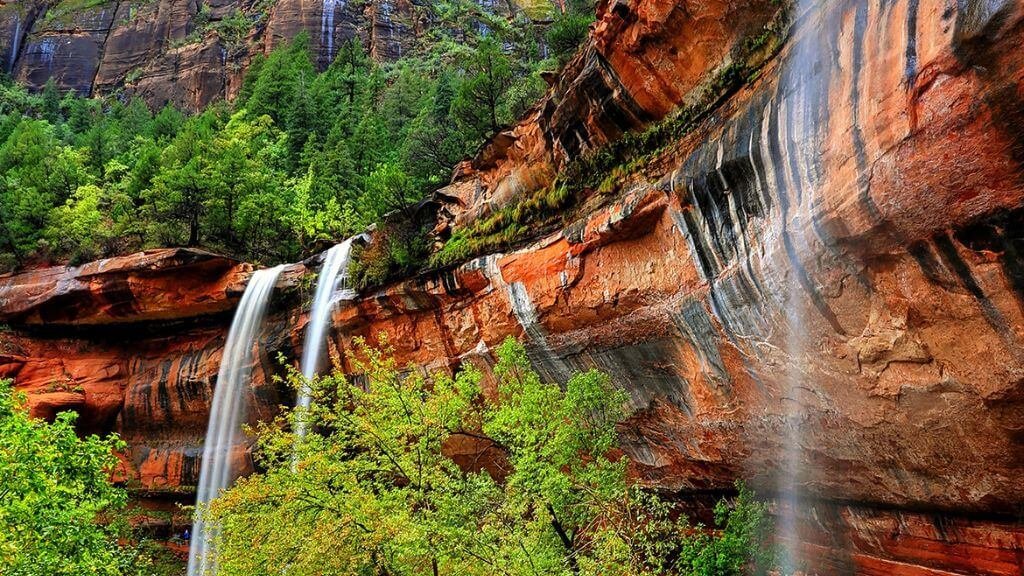
When the Emerald Pools Trail is mentioned, it’s crucial to recognize that it comprises three separate paths: Lower, Middle, and Upper Emerald Pool Trails, each varying in length, elevation gain, and difficulty:
- The Lower Emerald Pool Trail is an easy, 0.6-mile round trip.
- The Middle Emerald Pool Trail extends an additional 0.2 miles each way, with a slight increase in elevation.
- The Upper Emerald Pool Trail is more challenging, adding another 0.8 miles each way and ascending several hundred feet.
Currently, the Middle and Upper trails are closed for repairs following a washout.
Checkerboard Mesa
A visit to Checkerboard Mesa is recommended for its distinctive rock patterns and color variations. This spot is also a perfect place to circle back towards the Visitor Center via the Mount Carmel Highway, an area frequented by Big Horn Sheep sightings.
The unique crisscross pattern of the rocks is visible from the parking area, and even clearer with binoculars or a long lens. Time constraints on our one-day visit meant we didn’t hike here but focused on maximizing our itinerary.
Trail to Angels Landing
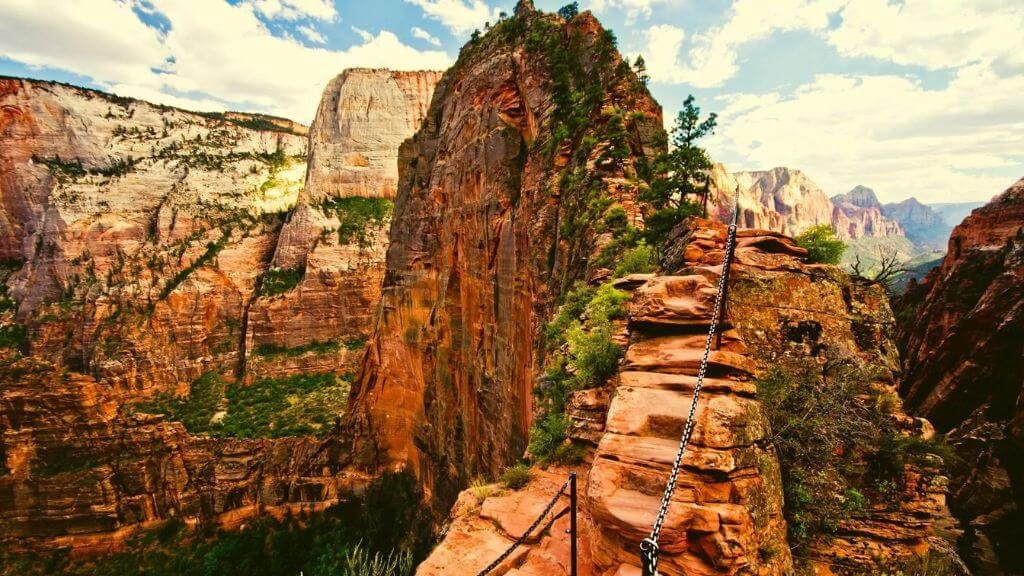
Angels Landing is renowned for its breathtaking and somewhat intimidating final ascent, a spectacle often shared on social media for its narrow paths and sheer drops. If your Zion National Park visit is limited to a single day, you might have to choose between tackling this hike or embarking on the Narrows, as both are demanding and time-consuming.
The journey to Angels Landing via the West Rim Trail spans approximately 5.4 miles round trip and includes an elevation gain of 1,488 feet, complete with challenging switchbacks. The climax of the hike is a precarious ridge leading to a stunning canyon viewpoint, navigated with the aid of a chain handrail.
To access the trail’s final stretch, hikers must obtain a permit, available through seasonal lotteries. It’s essential to check the official website for application details.
You Can Read: Things to Do in Colorado Springs
Zion Camping and Stargazing
The park’s atmosphere transforms at night, offering tranquility and a star-filled sky, as most visitors leave at dusk. Efforts to minimize light pollution include the use of LED lights and shaded fixtures.
For those wishing to immerse themselves in Zion’s nocturnal beauty, camping at one of the park’s campgrounds is an excellent option. The Watchman Campground, located near the visitor center, offers tent, group, and RV sites with electrical hookups, along with amenities such as toilets, potable water, and a dump station.
The South Campground, near the Zion Nature Center, provides a more rustic experience. Springdale, just outside the park, has additional camping and RV options.
Watchman Trail
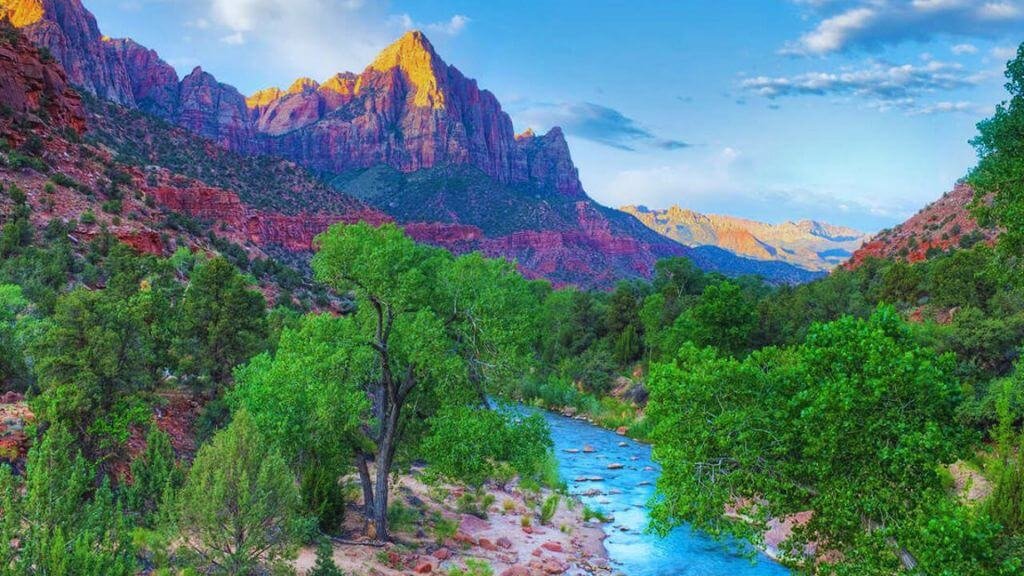
The Watchman Trail offers a moderate hike ideal for visitors looking to escape the crowds, ascend to higher elevations, and experience intimate views of the mountains. From this trail, hikers are rewarded with stunning perspectives of Watchman Peak and a comprehensive view of the lower Zion Canyon, including the Visitor Center beneath.
Kayenta Trail
For a more picturesque alternative to the complete Lower Emerald Pools Trail loop, consider veering onto the Kayenta Trail. This path was a delightful discovery during our exploration of Zion, despite not being widely mentioned in most guides.
This moderate, 2-mile trek skirts the canyon’s rim, offering breathtaking aerial vistas. (For those with young children, it’s advisable to keep them securely close or use a carrier due to the trail’s narrowness and the presence of steep cliffs.)
At the trail’s end, you’ll find a footbridge that leads directly to The Grotto’s shuttle stop (#6). Catching the shuttle from here back to the Zion Canyon Visitor Center is a convenient way to round off your day in Zion.
The Best Time to Visit Zion National Park
Zion National Park is a popular destination, attracting around 4.3 million tourists annually. The bulk of these visitors come during the summer months, from June to August, leading to crowded conditions.
To avoid the crowds and enjoy a more serene experience, consider scheduling your visit in the spring or fall. Not only will the park be quieter, but you’ll also face shorter waits for the shuttle and avoid hiking in intense heat.
Visiting in October or November is especially recommended. My own experience in mid-November was fantastic, with great weather, minimal crowds, and the park’s fall colors adding an extra layer of beauty to the trip.
Tips for Spending One Day in Zion National Park
Start Your Day Early: Zion is among the busiest national parks in America, so to fully enjoy its wonders, aim to arrive before 8 AM. This strategy typically ensures a parking spot in the shuttle area.
Start or End your day with Hiking: The iconic trails of Zion are less crowded early in the morning or later in the afternoon, while midday tends to bring peak traffic.
Bring Food and Water: Securing a parking spot for the shuttle can be challenging, particularly around noon, making it inconvenient to leave for food. Packing your food and drinks allows for a scenic picnic within the park, with water fountains available at various restrooms for refills.
Allocate ample time for trails: The heat and terrain can extend the time needed for hikes more than anticipated, especially during the summer.
Rely on the park’s shuttle system: Private vehicle access to Zion Canyon Scenic Drive is restricted from March to November, but shuttle buses serve the main attractions along this route. To avoid the rush, try to get to the shuttle parking before 8 AM.
Consider Springdale’s shuttle if Zion’s lot is full. The adjacent town offers its shuttle service to Zion Canyon Village, close to the park’s entrance, where you can transfer to the Zion shuttle.
Commit to leaving no trace: Ensuring you pack out all your trash is vital for preserving the park’s natural beauty. Use available bins for disposal, or take your trash with you to discard off-site.
Read More: Blue Heart Springs
Conclusion
Maximizing your one day in Zion National Park requires planning, flexibility, and a spirit of adventure. From the awe-inspiring hikes and scenic drives to the tranquil moments of sunset watching and stargazing, Zion offers a plethora of experiences that cater to nature lovers and adventurers alike. As you explore this majestic park, remember to tread lightly, respecting the environment and wildlife. By doing so, you not only ensure a memorable visit for yourself but also help preserve its beauty for future generations. Let Zion’s enchanting landscapes inspire you to explore responsibly and cherish every moment spent within its bounds.
Frequently Asked Questions (FAQs)
Is it worth it to spend one day in Zion?
To address the question upfront, one day in Zion National Park hardly does it justice. However, understanding that time constraints are real, it’s perfectly fine if that’s all the time you have.
Spending just one day in Zion National Park, albeit brief, serves as a tantalizing preview that will undoubtedly leave you yearning for more. It’s sufficient to witness the iconic, majestic red cliffs and experience a hint of the park’s enchanting allure.
Is one day enough time in Zion?
Having only one day to spend in Zion still promises an incredible experience, as the park’s stunning beauty can be glimpsed within this brief timeframe. To make the most of your day, it’s advisable to start at sunrise, maximizing every moment available. However, for a more thorough exploration of Zion National Park, allocating two to three days would be ideal.
Should I stay the night in Zion?
Absolutely, I highly recommend it. After a day filled with hiking and navigating shuttles, being able to unwind in a hotel is invaluable. My stay at Zion Wildflower Resort was exceptional and truly enhanced the experience!
How long does the Narrows Hike Take?
The duration of the Narrows Hike can vary greatly, as it really depends on how far you wish to explore. There’s no definitive end or specific viewpoint, making the entire journey picturesque. Personally, I ventured approximately 2.5 to 3 hours into the canyon until it narrowed significantly before deciding to turn back.
When is the best time to visit Zion National Park?
Visiting Zion from Spring to Fall (April to November) is ideal. Although summer brings the largest crowds, opting for the spring or fall seasons can provide a more serene experience with fewer visitors.


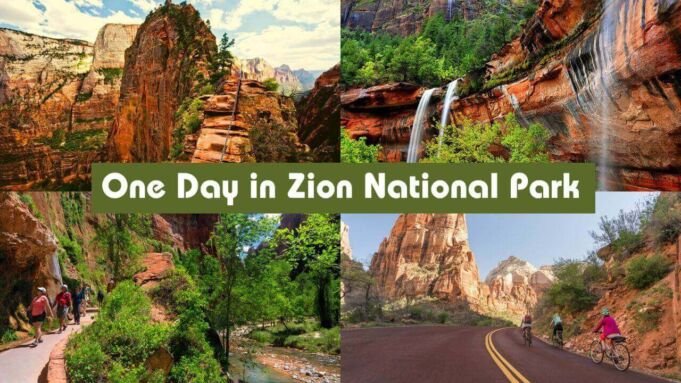

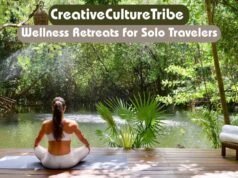
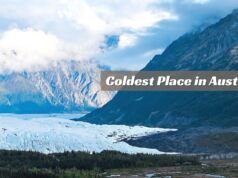










[…] Related: One Day in Zion National Park […]
Comments are closed.